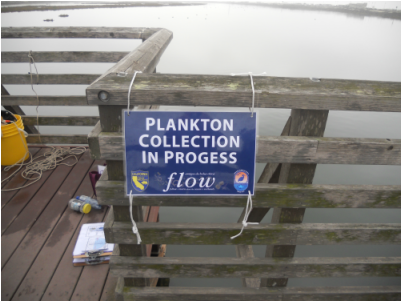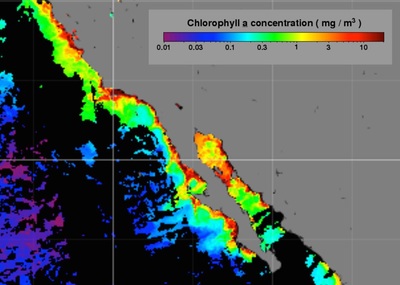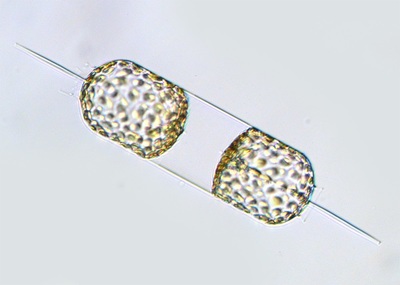|
Plankton: so tiny but so mighty!
Did you know that plankton are responsible for producing half of the oxygen in the earth's atmosphere? And that, in the process of doing so they remove CO2 from the atmosphere, which ultimately reduces the effects of global warming? These organisms- mostly microscopic protists and animals that drift in the world ocean- form the basis or aquatic food webs and play important roles in major biogeochemical cycles. And yet, most of us humans, know little or nothing about them. |
KNOW THY PLANKTON
Here, I have compiled some resources and links to websites that we think can be enlightening and helpful for anyone who wishes to know more about plankton (Note: this was originally created for new FLOW Citizen Scientists which I train to monitor plankton and water quality at the Bolsa Chica Ecological Reserve in Huntington Beach, CA, but I think it serves as a useful step-by-step initial guide to anyone interested in learning about marine phytoplankton)
1. Begin your journey by visiting the FLOW Citizen Science Program webpage.
http://www.amigosdebolsachica.org/flow.php
There, you will get a general overview of what we do at FLOW and an introduction to plankton and harmful algae. Our website also includes a list of links to external websites that we think you should visit, including a link to the California Dept. of Public Health’s Phytoplankton Monitoring Program, which we are a part of. You can read the State Program’s monthly, quarterly and annual reports by going to these websites:
http://www.cdph.ca.gov/HealthInfo/environhealth/water/Pages/phytoplanktonmonitoringprogram.aspx
http://www.cdph.ca.gov/HealthInfo/environhealth/water/Pages/Shellfishreports.aspx
2. Watch some videos:
here is a selection of terrific short videos that will provide you with a good understanding of plankton and their importance.
2.1. This one -- Alien Deep: Dr. Lampitt's Plankton -- was made by National Geographic
http://education.nationalgeographic.com/education/media/plankton-revealed/?ar_a=1
2.2. This video – Planet Plankton -- was made by the NOAA (National Oceanic and Atmospheric Administration)
http://estuaries.noaa.gov/teachers/plankton.aspx
2.3. This video -- The Secret Life of Plankton -- was produced by TED-Ed
http://ed.ted.com/lessons/the-secret-life-of-plankton
2.4. Finally, this video – Visualizing Plankton – was produced by the Center for Microbial Oceanography: Research and Education (C-MORE) http://cmore.soest.hawaii.edu/video/steward_video.htm
3. Get to know the plankton. Much of what we do at FLOW involves identifying certain groups and species of plankton that are of interest to us because they are potentially harmful and/or seasonal. You will learn to identify them by practicing and using ID guides such as the ones we provide you with (You will receive digital copies of ID guides via email).
We don’t expect you to memorize all these scientific names- it will happen naturally, as you continue to attend FLOW activities and see these organisms in our water samples from time to time. You can also learn more about plankton taxonomy, identification and ecology by visiting the following websites:
http://botany.si.edu/references/dinoflag/taxa.htm
http://oceandatacenter.ucsc.edu/PhytoGallery/phytolist.html
http://www.eos.ubc.ca/research/phytoplankton/index.html
http://phytoplanktonguide.lumcon.edu/browse.asp?pagenum=1
https://beagle.whoi.edu/redmine/projects/ifcb-man/wiki/Diatoms
http://species-identification.org/index.php?groep=Dinoflagellates&selectie=24&hoofdgroepen_pad=%2C3%2C24
5. Finally, learn more about the connections between algal blooms and nutrients. A common question we hear from newbies is “What causes certain plankton blooms to occur?” Plankton bloom dynamics is a very complex topic, which is still poorly understood by science. We have a good understanding of what CAN cause blooms to form in general (i.e. sunlight, temperature and salinity ranges, and nutrients) and we also know that there are some specific factors that may serve as an advantage to certain groups, which can then reproduce much faster than other populations in that plankton community (e.g. the availability of silica, which would benefit diatoms but be indifferent to dinoflagellates). Other environmental conditions that may prevent or promote blooms to form, which may be seasonal or not, are wind conditions and sediments being stirred up by turbulence, ocean currents that may bring with it micronutrients and/or new plankton strains and cysts, water column stratification, among others. On the other hand, science is still struggling to pinpoint which factor (or factors) trigger specific blooms, in specific locations, times and species. And we know even less about which factors may trigger the production of toxins in harmful algal blooms! Here are a few links to websites that offer reading materials on algal blooms that may help you to better understand what we know (and don’t know) about phytoplankton blooms:
http://floridakeys.noaa.gov/scisummaries/wqpb.pdf
http://www.nwfsc.noaa.gov/hab/habs_toxins/phytoplankton/algal_dynamics.html
By the way, one common limiting factor for phytoplankton blooms is the availability of iron as a nutrient. You may have heard about the iron fertilization controversy? If not, read about it here:
http://www.livescience.com/24025-illegal-iron-dumping-phytoplankton-bloom.html
You may also be interested in reading more about eutrophication:
http://www.wri.org/project/eutrophication/about
http://oceanservice.noaa.gov/podcast/jan09/dd12309transcript.html
OH, and of course... CHECK OUT MY PLANKTON VIDEOS ON YOUTUBE!!!
1. Begin your journey by visiting the FLOW Citizen Science Program webpage.
http://www.amigosdebolsachica.org/flow.php
There, you will get a general overview of what we do at FLOW and an introduction to plankton and harmful algae. Our website also includes a list of links to external websites that we think you should visit, including a link to the California Dept. of Public Health’s Phytoplankton Monitoring Program, which we are a part of. You can read the State Program’s monthly, quarterly and annual reports by going to these websites:
http://www.cdph.ca.gov/HealthInfo/environhealth/water/Pages/phytoplanktonmonitoringprogram.aspx
http://www.cdph.ca.gov/HealthInfo/environhealth/water/Pages/Shellfishreports.aspx
2. Watch some videos:
here is a selection of terrific short videos that will provide you with a good understanding of plankton and their importance.
2.1. This one -- Alien Deep: Dr. Lampitt's Plankton -- was made by National Geographic
http://education.nationalgeographic.com/education/media/plankton-revealed/?ar_a=1
2.2. This video – Planet Plankton -- was made by the NOAA (National Oceanic and Atmospheric Administration)
http://estuaries.noaa.gov/teachers/plankton.aspx
2.3. This video -- The Secret Life of Plankton -- was produced by TED-Ed
http://ed.ted.com/lessons/the-secret-life-of-plankton
2.4. Finally, this video – Visualizing Plankton – was produced by the Center for Microbial Oceanography: Research and Education (C-MORE) http://cmore.soest.hawaii.edu/video/steward_video.htm
3. Get to know the plankton. Much of what we do at FLOW involves identifying certain groups and species of plankton that are of interest to us because they are potentially harmful and/or seasonal. You will learn to identify them by practicing and using ID guides such as the ones we provide you with (You will receive digital copies of ID guides via email).
We don’t expect you to memorize all these scientific names- it will happen naturally, as you continue to attend FLOW activities and see these organisms in our water samples from time to time. You can also learn more about plankton taxonomy, identification and ecology by visiting the following websites:
http://botany.si.edu/references/dinoflag/taxa.htm
http://oceandatacenter.ucsc.edu/PhytoGallery/phytolist.html
http://www.eos.ubc.ca/research/phytoplankton/index.html
http://phytoplanktonguide.lumcon.edu/browse.asp?pagenum=1
https://beagle.whoi.edu/redmine/projects/ifcb-man/wiki/Diatoms
http://species-identification.org/index.php?groep=Dinoflagellates&selectie=24&hoofdgroepen_pad=%2C3%2C24
5. Finally, learn more about the connections between algal blooms and nutrients. A common question we hear from newbies is “What causes certain plankton blooms to occur?” Plankton bloom dynamics is a very complex topic, which is still poorly understood by science. We have a good understanding of what CAN cause blooms to form in general (i.e. sunlight, temperature and salinity ranges, and nutrients) and we also know that there are some specific factors that may serve as an advantage to certain groups, which can then reproduce much faster than other populations in that plankton community (e.g. the availability of silica, which would benefit diatoms but be indifferent to dinoflagellates). Other environmental conditions that may prevent or promote blooms to form, which may be seasonal or not, are wind conditions and sediments being stirred up by turbulence, ocean currents that may bring with it micronutrients and/or new plankton strains and cysts, water column stratification, among others. On the other hand, science is still struggling to pinpoint which factor (or factors) trigger specific blooms, in specific locations, times and species. And we know even less about which factors may trigger the production of toxins in harmful algal blooms! Here are a few links to websites that offer reading materials on algal blooms that may help you to better understand what we know (and don’t know) about phytoplankton blooms:
http://floridakeys.noaa.gov/scisummaries/wqpb.pdf
http://www.nwfsc.noaa.gov/hab/habs_toxins/phytoplankton/algal_dynamics.html
By the way, one common limiting factor for phytoplankton blooms is the availability of iron as a nutrient. You may have heard about the iron fertilization controversy? If not, read about it here:
http://www.livescience.com/24025-illegal-iron-dumping-phytoplankton-bloom.html
You may also be interested in reading more about eutrophication:
http://www.wri.org/project/eutrophication/about
http://oceanservice.noaa.gov/podcast/jan09/dd12309transcript.html
OH, and of course... CHECK OUT MY PLANKTON VIDEOS ON YOUTUBE!!!




